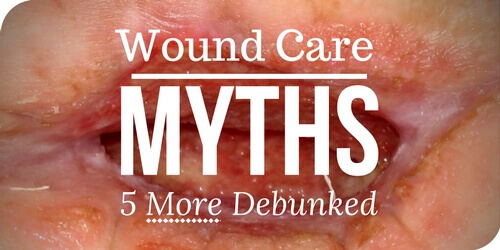Whether it involves heel protectors, anti-embolism stockings, or letting wounds “breathe,” there are still plenty of wound-care myths circulating out there. Ready for the truth? You can handle it.
Do you use wet-to-dry dressings in order to save money? Have you administered oral antibiotics to treat infected wounds? And do you follow physicians’ orders for wound treatments even though you know they’re inappropriate?
If you answered yes to any of these questions, then you are not alone. You are among a host of other professionals who have believed or participated in some of the most common wound care myths. In an earlier post, we revealed why these and other wound care myths simply need to go away. But wait! Here are five more myths that run counter to the evidence and wound care standards that guide our clinical practice.
Myth: Heel protectors prevent pressure on the heels.
Fact: Absolutely not. Heel protectors have no pressure reduction or pressure redistribution qualities whatsoever. They only protect against friction – two surfaces rubbing against each other.
According to the 2014 NPUAP guidelines, all patients at risk of breakdown, as well as those with pressure injuries on the heel, should have their heels completely free of the bed’s surface. So at minimum, we need to float the heels. But for patients with Stage 3 or 4 pressure injuries, the NPUAP strongly recommends a suspension boot that cradles the lower leg and does not allow the heel to make contact with any surface. With such a device, patients can reposition themselves in bed without fear of losing the pressure offload.
Myth: You should never put anything in the wound that you wouldn’t put in your eye.
Fact: This is reasonable advice for the general public. However, many FDA-approved wound care products caution against eye contact. Amorphous hydrogel dressings, for example, are great for donating moisture to a wound. But you would never want hydrogel to make contact with an eye.
So how do you know what can be safely administered to a wound? Follow manufacturer’s instructions, get to know your product reps, and above all, stay educated about the standards of care through seminars, webinars, journals and courses.
Myth: Wounds need to “breathe.”
Fact: Perhaps this myth exists because, as human beings, we generally prefer fresh air and light over dark, damp and enclosed spaces. Or maybe it’s simply that we can’t let go of the advice our parents gave us as children. Whatever the reason, the idea that wounds need to “breathe” lingers in popular culture and sometimes spills over into clinical practice.
The evidence is clear. The optimum environment for healing chronic wounds is moist and warm (near normal body temperature). An uncovered wound allows water vapor loss, which leads to heat loss. Even a 2°C drop in temperature can delay wound healing, and it can take up to four hours to reach normal healing temperature. Tissue cooling also causes vasoconstriction, which decreases the oxygen available for white blood cells to fight off infection.
So forget the impulse to “air out” a chronic wound. Choose dressings (such as foam) that insulate the wound bed, support moist wound healing, and incorporate technology that minimizes frequent changes. The faster healing times and reduced rates of infection more than offset the costs of such dressings. Moreover, it’s the standard of care.
Myth: All eschar must be debrided for wound healing to occur.
Fact: You’ve probably learned that devitalized tissue – such as eschar – impairs healing, providing a growth medium for bacteria that increases infection risk. It also exudes endotoxins that inhibit the migration of those helpful fibroblasts and keratinocytes into the wound. And yes, necrotic tissue prevents the formation of granulation tissue, wound contraction and epitheliatization.
Nonetheless, stable eschar – that is, dry, adherent, intact eschar without erythema (redness) or fluctuance (wave-like movement when palpated) – should not be removed. It is the body’s natural protective cover. In particular, don’t debride stable eschar on the heels when healing is not an option, or when there is no blood flow.
Myth: Anti-embolism stockings can be used for treatment of venous ulcers.
Fact: White anti-embolism stockings are designed specifically for bed-bound, non-ambulatory patients to help prevent blood clots. For active treatment of venous ulcers, we use compression therapy, such as an Unna’s Boot, Duke Boot, adjustable short-stretch compression wrap systems or multilayer compression bandages. Once the acute phase has diminished, graduated medical compression stockings can be used. But those white anti-embolism stockings? They do not provide enough compression to meet the technical specifications for use by ambulatory patients. Follow the manufacturer’s instructions and use them where they are effective – in bed!
Tell us about your wound care myths
Do you hear these wound care myths? Have you seen fellow clinicians, physicians or other caregivers perpetuate them at your facility? What other wound care myths or falsehoods should we tackle? Please leave your ideas, suggestions and comments below.
Wound Care Education Institute® provides online and onsite courses in the fields of Skin, Wound, Diabetic and Ostomy Management. Health care professionals who meet the eligibility requirements may sit for the prestigious WCC®, DWC® and OMS national board certification examinations through the National Alliance of Wound Care and Ostomy® (NAWCO®). For more information see wcei.net.
What do you think?

